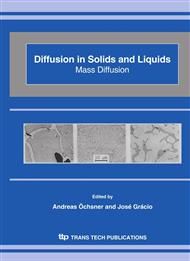p.118
p.124
p.130
p.137
p.146
p.152
p.158
p.164
p.172
Interstitial Diffusion of Oxygen in Tantalum Obtained by Anelastic Relaxation Measurements
Abstract:
Anelastic relaxation measurements have been used in order to obtain information about several aspects of the behavior of solutes in metals, for example, matrix-solute interaction, interstitial diffusion, etc. The diffusion coefficient for interstitial solutes in body centered-cubic metals is accurately determined by anelastic relaxation measurements. The kind of preferential occupation of the interstitial solutes in body centered-cubic metals, such as oxygen and nitrogen in tantalum, is still controversial. Internal friction and frequency measurements as a function of temperature in tantalum sample were performed using a torsion pendulum operating in a frequency oscillation in the hertz bandwidth. These results presented the following phenomenon: the intensity of the internal friction peak decreased between the first run and the other runs. These results were decomposed, by the successive subtraction method, in elementary Debye peaks, for determination of characteristic anelastic relaxation parameters (relaxation strength, peak temperature, activation energy and relaxation time). Interstitial diffusion coefficients for oxygen in tantalum were determined, for different intensities of internal friction peaks, and when compared with literature, these results introduced a better adjustment for the tetrahedral preferential occupation sites of oxygen in tantalum.
Info:
Periodical:
Pages:
146-151
Citation:
Online since:
October 2006
Keywords:
Price:
Сopyright:
© 2006 Trans Tech Publications Ltd. All Rights Reserved
Share:
Citation:


